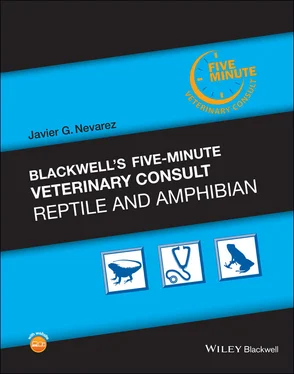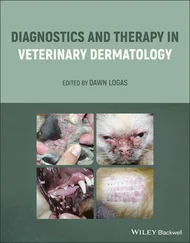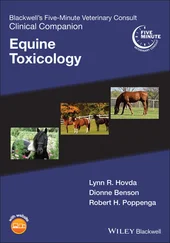After the sutures are removed, the tissue may re‐prolapse if swelling/inflammation are still present or the underlying etiology has not been corrected.
Placement of additional sutures may be required. Hydration status of the patent must be considered before use of NSAIDs.
 FOLLOW‐UP
FOLLOW‐UP
PATIENT MONITORING
The patient should be followed up daily after clinical repair of the prolapse for reoccurrence.
The owner should monitor and record all food intake and defecations during this time.
Any abnormal changes should be related back to the veterinarian to determine any further changes to the therapy.
EXPECTED COURSE AND PROGNOSIS
Prolapses of the oviduct and bladder tend to have a guarded to grave prognosis due to the degree of underlying physical damage to the affected tissues and cloaca.
Rectal and cloacal prolapses tend to have a fair prognosis if treated promptly.
Phallus prolapses have excellent to good prognosis, as these are purely copulatory organs.
The length of time the prolapse presents has an inverse effect on the prognosis.
When treated early in the disease process and the tissue appears viable, cloacal prolapse replacement may lead to clinical resolution if the underlying etiology is addressed.
Once the tissue begins to desiccate and become devitalized, there is a guarded to grave prognosis.
 MISCELLANEOUS
MISCELLANEOUS
COMMENTS
N/A
N/A
N/A
CBC = complete blood count
NSAIDs = nonsteroidal anti‐inflammatory drugs
UVB = ultraviolet B
1 Barten, SL. Penile prolapse. In: Mader DR, ed. Reptile Medicine and Surgery. 2nd ed. St. Louis, MO: Elsevier Saunders; 2006:862–864.
2 Bennett, RA. Cloacal prolapse. In: Mader DR, ed. Reptile Medicine and Surgery. 2nd ed. St. Louis, MO: Elsevier Saunders; 2006:751–755.
AuthorRob L. Coke, DVM, DACZM, DABVP (Reptile & Amphibian), CVA
Conjunctivitis
 BASICS
BASICS
DEFINITION/OVERVIEW
Conjunctivitis is defined as inflammation of the conjunctiva. In reptiles, conjunctivitis often presents concurrently with blepharedema, which is edema and swelling of the eyelids. In many cases, the blepharedema is severe enough to impede proper evaluation of the eye and hence identification of conjunctivitis. Blepharoconjunctivitis is a common presentation.
Conjunctivitis is most often caused by viral or bacterial infections.
Other etiologies include fungal or parasitic infection, poor water quality, and environmental irritants or toxins.
Trauma may also be a cause, especially in cases of unilateral conjunctivitis.
There is no specific signalment for the occurrence of conjunctivitis.
The main focus should be on obtaining a thorough history of the husbandry.
In addition to the conjunctivitis itself, chelonians often present with blepharedema, blepharospasm, and/or periocular swelling usually affecting both eyes and causing blepharoconjunctivitis.
Animals may also present with anorexia, depression and lethargy due to either the systemic effects of the underlying etiology (e.g., herpes virus) or simply from their inability to see properly.
Poor cleanliness and hygiene of the enclosure can lead to increased environmental bacterial load, which can contribute to conjunctivitis.
Poor water quality for aquatic chelonians causing high ammonia levels.
N/A
 DIAGNOSIS
DIAGNOSIS
DIFFERENTIAL DIAGNOSIS
Herpes virus
Ranavirus
Mycoplasmosis
Chlamydiosis
Toxin exposure (ammonia, aromatic oils from cedar chips)
Trauma
Parasitic (leeches or trematodes)
A complete ophthalmic examination with the use of magnification by direct or indirect ophthalmoscopy including fluorescein test for corneal ulcers.
Sampling of the conjunctiva for bacterial culture and sensitivity.
PCR for herpes virus, ranavirus, Mycoplasma sp., or Chlamydia sp., according to other clinical signs and presentation.
Blepharoconjunctivitis is a common presentation.
Plaques or caseous material may be observed within the fornix or even covering the corneal surface.
Mucopurulent discharge
 TREATMENT
TREATMENT
APPROPRIATE HEALTH CARE
Treatment will be based on the underlying etiology; anti‐inflammatories and analgesics should be considered in most cases.
Treatment of viral infections is often unrewarding.
Concurrent systemic and ophthalmic therapy is recommended for best response.
Flushing and cleaning of the eyes is also necessary to remove any adhered material or plaques that may be harboring organisms.
A solution of 1 part povidone iodine to 50 parts saline can be used.
When blepharedema is present, a pipette tip, tomcat catheter, or intravenous catheter can be inserted between the eyelids to flush the eyes.
In cases of anorectic animals, force‐feeding with easily digestible proteins should be initiated.
Direct feeding by stomach tubing can be performed in some species; placement of an esophagostomy tube should be considered for chronic management.
Supportive fluid therapy should be provided.
CLIENT EDUCATION/HUSBANDRY RECOMMENDATIONS
Remove and isolate sick individuals and reduce stress by providing optimal living conditions and hygiene.
Thorough cleaning of cage to reduce environmental load of infectious organisms.
Ensure that quarantine protocols have been implemented for all new arrivals.
Treatment compliance is key for response to therapy.
 MEDICATIONS
MEDICATIONS
DRUG(S) OF CHOICE
Systemic Therapy
Meloxicam: 0.5 mg/kg IM, PO q24h
Dexamethasone sodium phosphate —0.1–0.3 mg/kg IM, SC, IV q24h for 3 days
Ceftazidime: 22 mg/kg IM q72h
Ceftiofur crytasalline free acid: 30 mg/kg SC q5d
Amikacin: 5 mg/kg IM q48h
Enrofloxacin: 5–10 mg/kg IM, PO q24–48h
Oxytetracycline: 5–10 mg/kg IM q24h; 10 mg/kg IM q5d for long‐acting formulation
Читать дальше

 FOLLOW‐UP
FOLLOW‐UP MISCELLANEOUS
MISCELLANEOUS BASICS
BASICS DIAGNOSIS
DIAGNOSIS TREATMENT
TREATMENT MEDICATIONS
MEDICATIONS










